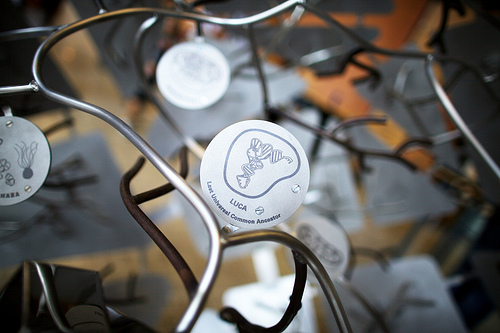


The 2010 meeting of the Society for Molecular Biology
and Evolution (SMBE)
took place at the Lyon Convention Center
located between the river Rhône and the Parc de la Tête d’Or in July
4-8 2010 .
The meeting attracted about 1,100 delegates from 45 countries (with
most delegates coming from the USA), which made it one of the largest
SMBE meetings. The scientific program included 4 plenary lectures and
28
symposia grouped into four general topics: Genome Evolution, Population
Genomics/Theory, Phylogenomics, Molecular Evolution and Phenotypes. As
usual the society organized the Fitch prize symposium and the
undergraduate mentoring program poster session. In total, the
scientific program included about 250 talks and about 600 posters. The
gala dinner and award ceremony took place at the Brasserie Georges with
600 of the participants. For the first time at an SMBE meeting, plenary sessions and Fitch session were filmed and can
be
found below:
Jenny GRAVES, The
Australian National University Canberra, AUSTRALIA
Weird animal genomes and
sex
In humans and other mammals, females have two X chromosomes, but males
have a single X, and a Y that bears a gene (SRY) that induces testis
differentiation and switches on hormones that masculinize the embryo.
The human X is a middle-sized chromosome, rich in “brains-and-balls”
genes involved in reproduction and intelligence (often both), and
thought to have had a major role in human evolution. The tiny Y is a
genetic wasteland – full of repetitive sequence and bearing only 45
genes, most active only in testis. How did human sex chromosomes get to
be so weird? Our strategy is to compare the chromosomes, genes and DNA
in distantly related mammals and even birds and reptiles (which have
completely different sex determining systems). The genomes of
Australia’s unique kangaroos and platypus, now being completely
sequenced, are a goldmine of new information. Kangaroo sex chromosomes
reveal the original mammal sex chromosomes, while the bizarre platypus
sex chromosomes (more related to those of birds) tell us that our sex
chromosomes are relatively young. The human X and Y evolved from an
ordinary chromosome pair as the Y degraded progressively. The Y is
predicted to disappear in just 5 million years. If humans don’t become
extinct, new sex determining genes and chromosomes will evolve, maybe
leading to the evolution of new hominid species.
Jody HEY, Rutgers
University New Jersey, USA
On the causes of species
(Nei Lecture)
Species are complicated. While the taxonomic rank of species is a
necessary concept, the actual identification of species is an often
subjective process. And once they are identified, the elucidation of
why two species have diverged from a common ancestor, is difficult to
study. In recent decades the focus of genetic research on divergence
has shifted down from the taxonomic rank of species to focus on
populations. Populations can be more objective, and divergence of
populations is at least a necessary process for the formation of
species. Results from a great many research programs seem to have
overturned the once dominant view of how species form, and replaced it
with a much more complex framework involving a large role for
diversifying natural selection, often in the face of gene exchange.
Results from analyses of Isolation-with-Migration models support this
picture, with many divergent populations showing clear signs of having
exchanged genes during their divergence.
Katie PEICHEL, Fred
Hutchinson Cancer Research Center Seattle, USA
Fishing for the secrets
of vertebrate evolution
What is the genetic basis of morphological and behavioral variation
between species? How do these differences lead to the formation of new
species? In order to address these questions experimentally, the
threespine stickleback (Gasterosteus aculeatus) has been developed as a
new genetic and genomic model system. Threespine sticklebacks have
evolved an incredible diversity of morphologies and behaviors in
freshwater populations in the last 10,000 years, and we have the
ability to cross virtually any two diverse populations of sticklebacks
using artificial fertilization in the lab. Therefore, they are an ideal
system to determine the number of genetic changes that control
morphological and behavioral differences between species, to map the
location of these changes, and to ultimately find the DNA sequence
changes responsible for evolutionary modifications in vertebrates.
Recent work in my laboratory has focused on both morphological and
behavioral traits that contribute to reproductive isolation between
stickleback populations, providing insight into the genetic and
developmental processes that underlie speciation.
Patrick FORTERRE,
Institut Pasteur Paris, FRANCE
The origin and nature of
viruses
Viruses are the most abundant living organisms in the biosphere. Recent
work has shown that they are also very ancient,
i.e. they
predated modern cells, the descendents of LUCA (the Last Universal
Cellular Ancestor). Traditional views have confused viruses with their
virions (the viral gene dissemination system) and underestimated their
role in biological evolution. Recently, a better understanding of
viruses antiquity and diversity, as well as the discovery of giant
viruses, have led to new concepts on the origin and nature of viruses.
Focusing on the intracellular stage of the virus life cycle, some
evolutionists have started to realize that viruses can create new
proteins (something well known by virologists) and that many proteins
now active in Archaea, Bacteria or Eukarya might have had initially a
viral origin. This seems to be especially true for proteins involved in
DNA manipulation, suggesting that DNA itself might have originated in
ancient viral lineages. I will illustrate this point by our recent
discovery of new families of viral/plasmid DNA polymerases and DNA
topoisomerases that have recently invaded some cellular genomes. I will
conclude that the interaction between viruses and cells has always been
the major engine of biological evolution in a Darwinian scheme ;
viruses being both the main actors responsible for both cell
diversification and
selection.
Yingguang frank CHAN
From
Trait to Base Pairs: Adaptive Evolution of Pelvic Reduction in
Sticklebacks by Recurrent Deletion of a Pitx1 Enhancer
Marc HOEPPNER
Using a comparative genomics approach to test the RNA world origin of
introns
Daniel MATUTE
The rate of evolution of hybrid incompatibilities in Drosophila
Susanne
PFEIFER
PanMap: Mapping genomic variation in chimpanzees
Melody RYNERSON
Characterizing the abalone sperm proteome and the evolution of a newly
discovered sperm protein
James SUN
A high resolution estimate of the human microsatellite mutation rate
Takashi TSUCHIMATSU
(Winner of
the 2010 W. Fitch prize)
Evolution of self-compatibility in Arabidopsis thaliana by a mutation
in the male specificity gene
Maria WARNEFORS
Transposable elements: insertion pattern and impact on gene expression
evolution in hominids
All the contents remain the
entire property of the authors.
Multimedia was created
at ENS de Lyon by UNIS and ENSMedia, sessions were filmed by
chezmoiprod, editing and
synchronization of
the slides were done by Olivier Chassaing, pHD student at
IGFL, ENS de Lyon.





